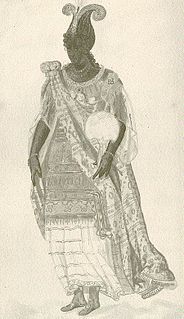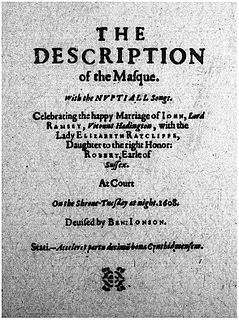Related Research Articles

The Masque of Blackness was an early Jacobean era masque, first performed at the Stuart Court in the Banqueting Hall of Whitehall Palace on Twelfth Night, 6 January 1605. It was written by Ben Jonson at the request of Anne of Denmark, the queen consort of King James I, who wished the masquers to be disguised as Africans. Anne was one of the performers in the masque along with her court ladies, all of whom appeared in blackface makeup.

Hymenaei, or The Masque of Hymen, was a masque written by Ben Jonson for the marriage of Robert Devereux, 3rd Earl of Essex, and Lady Frances Howard, daughter of the Earl of Suffolk, and performed on their wedding day, 5 January 1606. The costumes, sets, and scenic effects were designed by Inigo Jones, and the music composed by Alfonso Ferrabosco.
Love's Welcome at Bolsover is the final masque composed by Ben Jonson. It was performed on 30 July 1634, three years before the poet's death, and published in 1641.

Ben Jonson collected his plays and other writings into a book he titled The Workes of Benjamin Jonson. In 1616 it was printed in London in the form of a folio. Second and third editions of his works were published posthumously in 1640 and 1692.
Chloridia: Rites to Chloris and Her Nymphs was the final masque that Ben Jonson wrote for the Stuart Court. It was performed at Shrovetide, 22 February 1631, with costumes, sets and stage effects designed by Inigo Jones.
Oberon, the Faery Prince was a masque written by Ben Jonson, with costumes, sets and stage effects designed by Inigo Jones, and music by Alfonso Ferrabosco and Robert Johnson. Oberon saw the introduction to English Renaissance theatre of scenic techniques that became standard for dramatic productions through the coming centuries.
Love Freed from Ignorance and Folly was a Jacobean era masque, written by Ben Jonson and designed by Inigo Jones, with music by Alfonso Ferrabosco. It was performed on 3 February 1611 at Whitehall Palace, and published in 1616.
Love Restored was a Jacobean era masque, written by Ben Jonson; it was performed on Twelfth Night, 6 January 1612, and first published in 1616. The Dictionary of National Biography says of the masque, "This vindication of love from wealth is a defense of the court revels against the strictures of the puritan city."

The Hue and Cry After Cupid, or A Hue and Cry After Cupid, also Lord Haddington's Masque or The Masque at Lord Haddington's Marriage, or even The Masque With the Nuptial Songs at the Lord Viscount Haddington's Marriage at Court, was a masque performed on Shrove Tuesday night, 9 February 1608, in the Banqueting House at Whitehall Palace. The work was written by Ben Jonson, with costumes, sets, and stage effects designed by Inigo Jones, and with music by Alfonso Ferrabosco – the team of creators responsible for previous and subsequent masques for the Stuart Court.
Mercury Vindicated from the Alchemists at Court is a Jacobean-era masque, written by Ben Jonson and designed by Inigo Jones. It was performed at Whitehall Palace on Twelfth Night, 6 January 1615. King James I liked it so much that he ordered a repeat performance the following Sunday, 8 January.
The Fortunate Isles and Their Union is a Jacobean era masque, written by Ben Jonson and designed by Inigo Jones, and performed on 9 January 1625. It was the last masque acted before King James I of England, and therefore the final masque of the Jacobean era.
Neptune's Triumph for the Return of Albion was a Jacobean era masque, written by Ben Jonson, and designed by Inigo Jones. The masque is notable for the contradictory historical evidence connected with it and the confusion it caused among generations of scholars and critics.
The Coronation Triumph is a Jacobean era literary work, usually classed as an "entertainment," written by Ben Jonson for the coronation of King James I and performed on 15 March 1604. Jonson's work was half of a total performance, the other half written by Thomas Dekker. The work was especially significant in the developing literary career of Jonson, in that it marked the commencement of his role as a writer of masques and entertainments for the Stuart Court, a role he would fill for the next three decades.
The Entertainment at Althorp, or The Althorp Entertainment, is an early Jacobean era literary work, written by Ben Jonson. It is also known by the alternative title The Satyr. The work marked a major development in Jonson's career, as the first of many entertainments and masques that he would write for the Stuart Court.
The Speeches at Prince Henry's Barriers, sometimes called The Lady of the Lake, is a masque or entertainment written by Ben Jonson in honour of Henry Frederick, Prince of Wales, the son and heir of King James I of England. The speeches were performed on 6 January 1610 in conjunction with the ceremony known as Prince Henry's Barriers.
Pleasure Reconciled to Virtue is a Jacobean era masque, written by Ben Jonson and designed by Inigo Jones. It was first performed on Twelfth Night, 6 January 1618, in the Banqueting House at Whitehall Palace. The work's failure on its initial performance, and its subsequent revision, marked a significant development in Jonson's evolving masque technique.
The Masque of Augurs was a Jacobean era masque, written by Ben Jonson and designed by Inigo Jones. It was performed, most likely, on Twelfth Night, 6 January 1622.
Time Vindicated to Himself and to his Honours was a late Jacobean era masque, written by Ben Jonson and with costumes, sets, and stage effects designed by Inigo Jones. James's son and heir Prince Charles led the dances of the principal masquers, as he had in several previous masques at the Stuart Court.
Lovers Made Men, alternatively titled The Masque of Lethe or The Masque at Lord Hay's, was a Jacobean era masque, written by Ben Jonson, designed by Inigo Jones, and with music composed by Nicholas Lanier. It was performed on Saturday 22 February 1617, and was significant in the development and acceptance of opera in seventeenth-century England.
Pan's Anniversary, or The Shepherd's Holiday was a Jacobean era masque, written by Ben Jonson and designed by Inigo Jones. The date of the masque's performance at the English Court has long been in dispute: while the earliest text assigns it to 1625, mid-twentieth-century scholars placed it on 19 June 1620, the king's birthday, at the royal palace at Greenwich. More recently, Martin Butler has argued for a date of 6 January 1621.
References
- ↑ E. K. Chambers, The Elizabethan Stage, 4 Volumes, Oxford, Clarendon Press, 1923; Vol. 3, p. 390.
- ↑ Michael Leapman, Inigo: The Troubled Life of Inigo Jones, Architect of the English Renaissance. London, Headline Book Publishing, 2003; p. 166.
- ↑ Chambers, Vol. 3, pp. 389-91.
- ↑ Ben Jonson, Works, C. H. Herford and Percy Simpson, eds., 11 Volumes, Oxford, Clarendon Press, 1925–52; Vol. 10, pp. 545-6.
- ↑ John Orrell, "The London Stage in the Florentine Correspondence, 1604–1618," Theatre Research International 3 (1977–78)
- ↑ Martin Butler and David Lindley, "Restoring Astraea: Jonson's masque for the fall of Somerset," English Literary History 61 (1994).
- ↑ Peter Holbrook, "Jacobean masques and the Jacobean peace," in: David Bevington and Peter Holbrook, eds., The Politics of the Stuart Court Masque, Cambridge, Cambridge University Press, 1998; p. 87.
- ↑ John Leeds Barroll, Anna of Denmark, Queen of England: A Cultural Biography, Philadelphia, University of Pennsylvania Press, 2001; p. 211.
- ↑ Jessica Malay, Anne Clifford's Autobiographical Writing (Manchester, 2018), p. 26.